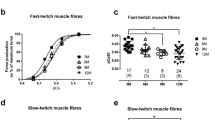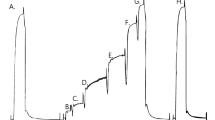Summary
Physical education students were subjected to electrical stimulation of relatively high frequency and current amplitude for 19 days. A quantitative study of several morphological parameters was performed on biopsy samples from gastrocnemius, using stereological methods at both light and electron microscopic levels. The main results were: muscle fibre size was increased; nuclear volume was also increased, suggesting that a proliferation of nuclei had occurred; this was paralleled by an increased content of nuclear DNA. The size of single myonuclei was increased, and their heterochromatin fraction was decreased, these changes being most pronounced in type II fibres. The increase in the mitochondrial fraction was also greatest in type II fibres. It is concluded that this type of electrical stimulation has predominant effects on type II fibres.
Similar content being viewed by others
References
Atherton GW, James NT, Mahon M (1981) Studies on muscle fiber splitting in skeletal muscle. Experientia 37:308–310
Carbric M, James NT (1983) Morphometric analysis on the muscles of exercise trained and untrained dogs. Am J Anat 166:359–368
Carbric M, James NT (1985) Quantitative changes in genoms of skeletal, diaphragma, and heart myonuclei caused by chronic hyperkinesis (in serbo-croatian). Kineziologija 1:15–18
Cabric M, Resic A (1987) Morphometric analysis of the nucleus and myonucleus DNA in skeletal muscles of athletes and non-athletes of both sexes (in serbo-croatian). Kineziologija 2:81–84
Cabric M, Appell H-J, Resic A (1987) Effects of electrical stimulation of different frequencies on the myonuclei and fibre size in human muscle. Int J Sports Med (in press)
Caspersson T (1950) Cell Growth and Cell Function. W. W. Norton, New York
Cruz-Orive LM (1980) On the estimation of particle number. J Microsc 120:156–167
David M (1977) Quantitative ultrastructural data of animal and human cells. G. Fischer, New York
Eisenberg BR, Brown JMC, Salmons S (1984) Restoration of fast muscle characteristics following cessation of chronic stimulation. Cell Tissue Res 238:221–230
Eisenberg BR, Salmons R (1981) The reorganization of subcellular structure in muscle undergoing fast-to-slow type transformation. Cell Tissue Res 220:449–471
Frenster JH, Allfrey VG, Mirsky AE (1963) Repressed and active chromatin isolated from interphase lymphocytes. Proc Natl Acad Sci USA 50:1026–1029
Gollnick PD, King DW (1969) Effect of exercise and training on mitochondria of rat skeletal muscle. Am J Physiol 216:1502–1509
Gupta PK (1976) Nuclear DNA, nuclear area and nuclear dry mass in thirteen species of Croalaria (Angiospermal, Leguminosal). Chromosoma 54:155–169
Holloszy JO (1967) Effects of exercise on mitochondrial oxygen uptake and respiratory activity in skeletal muscle. J Biol chem 242:2278–2282
Hoppeler H (1986) Exercise-induced ultrastructural changes in skeletal muscle. Int J Sports Med 7:187–204
Howald H (1975) Ultrastructural adaptation of skeletal muscle to prolonged physical exercise. In: Howald H, Poottmans JR (eds) Metabolic adaptation to prolonged physical exercise. Birkhäuser, Basel
James NT, Cabric M (1982) Quantitative analysis of normal and hypertrophic extensor digitorum longus muscle in mice. Exp Neurol 76:284–297
James NT, Cabric M, Wild MJ (1982) Qualitative and quantitative studies on Japanese Waltzing Mice. J Comp Pathol 92:533–545
Kuramoto M (1981) Relationship between number, size, and shape of red blood cells in Amphybians. Comp Biochem Physiol 69A:771–775
Lewis DM, Al-Amood WS, Rosendorff C (1986) Stimulation of denervated muscle. What do isometric and isotonic recordings tell us? In: Nix WA, Vrbová G (eds) Electrical stimulation and neuromuscular disorders. Springer, Berlin Heidelberg New York Tokyo, pp 101–113
Littau VC, Allfrey VG, Frenster HH, Mirsky AE (1964) Active and inactive regions of nuclear chromatin as revealed by electron microscope auto-radiography. Proc Natl Acad Sci USA 52:93–96
Nix WA, Vrbová G (1986) Electrical stimulation and neuromuscular disorders. Springer, Berlin Heidelberg New York Tokyo
Olmo E, Morescalchi A (1975) Evolution of the genome and cell size in salamanders. Experientia 31:804–806
Olmo E, Morescalchi A (1978) Genome and cell size in frogs: A comparison with salamanders. Experientia 34:4–46
Policard A (1972) Le Surface Cellulare et Son Microenvironnement. Masson, Paris
Salmons S, Henriksson J (1981) The adaptive response of skeletal muscle to increased use. Muscle Nerve 4:94–105
Schmitt O (1986) Treatment of idiopathic scoliosis with daily short-term electro-stimulation. In: Nix WA, Vrbová G (eds) Electrical stimulation and neuromuscular disorders. Springer, Berlin Heidelberg New York Tokyo, pp 132–143
Scott OM, Vrbová G, Hyde SA, Dubowitz V (1986) Effects of electrical stimulation on normal and diseased human muscle. In: Nix WA, Vrbová G (eds) Electrical stimulation and neuromuscular disorders. Springer, Berlin Heidelberg New York Tokyo, pp 125–131
Shah A, Nagao F, Sahgal V, Singh H (1985) Effect of nerve stimulation on rat skeletal muscle. A study of plasma membrane. Experimentia 41:1396–1398
Sieden D (1976) A quantitative analysis of muscle cell changes in compensatory hypertrophy and work induced hypertrophy. Am J Anat 145:459–468
Underwood EE (1970) Quantitative stereology. Reading, Mass Addison-Wesley
Weibel ER (1980) Stereological methods, vol. 2. Academic Press, London
Author information
Authors and Affiliations
Rights and permissions
About this article
Cite this article
Cabric, M., Appell, H.J. & Resic, A. Fine structural changes in electrostimulated human skeletal muscle. Europ. J. Appl. Physiol. 57, 1–5 (1988). https://doi.org/10.1007/BF00691229
Accepted:
Issue Date:
DOI: https://doi.org/10.1007/BF00691229




